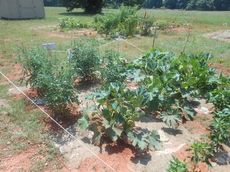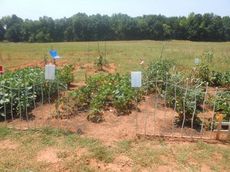
Cindy and Frank Brandeis take a welcome rest after attending to their garden plots at the Community Garden in GreerToday. The Brandeises are producing a watermelon patch with one plot and vegetables with another. They are from Illinois.

Cindy and Frank Brandeis maintain this garden plot. The manicured area shows effective weeding and watering.

The sign says it all. Be kind to your plants and they will be kind to you. This plot shows good maintenance, watering and fertilization.

A white-wired fence with hearts above is the gateway to this garden. The Community Garden will produce food for families and the excess will be distributed to Greer Relief and the Soup Kitchen.
Master Gardener
I went by the Community Garden Saturday morning. The new signs would indicate someone helped themselves to another person's vegetables. I hope not. The spirit of the Community Garden has been to provide folks with a place to plant and harvest their own vegetables and flowers.
The plots that are being cared for look good and healthy. There are some plots that appear to be abandoned to the weeds, but many are well maintained.
1. July is the most productive and the most difficult of the gardening months.
2. "Growing like a weed" was a thought process formed in July. Weed early in the morning and after rains for best results. Try not to let the weeds go to seed before you get them out. They compete for water and food with the desirable plants. Plots this size can be weeded thoroughly in less than an hour, but in this heat an hour can seem like a day.
3. Plants should be watered thoroughly at least twice a week when the heat is as constant as the last three weeks. It is best to gently apply water at the base of the plant. Rain is much better for the plants than city water. Rain picks up nitrogen from the air as it falls and feeds as well and hydrates the plants.
4. It is time for the second, or third, fertilization of the plants. Plants can take a larger dose of fertilizer now that they are mature. One half cup of 10-10-10 or other balanced fertilizer is an appropriate feeding for tomatoes, squash, cucumbers and cole crops (plants in the cabbage family). Peas and beans are legumes and fix (take) nitrogen from the air and deposit it in the soil. Fertilizing legumes makes the food energy go into the plant growth and short changes the fruit production. Scratch the fertilizer into a circle around the stems of the plant.
5. Several gardeners have asked questions about rotten spots on tomatoes and summer squashes. Every case I have observed was a temporary disease called “blossom end rot”.
Some calcium (bone meal, gypsum or calcium amendments) will normally cure that problem quickly. Pick off the bad fruit and wait for the next fruit to mature. Water in the calcium amendment thoroughly for best results.
6. Bugs have generally run their life cycle except for Japanese beetles and cucumber beetles, which stay active during the entire growing season. The best way to remove them is to pick them off by hand and drop them in soapy water. An empty soda bottle with a cap is a good vessel for collection. Of course, you can use the insecticides we recommended in earlier post; Sevin, Malathion and the organic BT.
7. Now is a good time to think about planting supplemental crops as the early crops (lettuce, summer squash, etc.) begin to end production and wilt. Okra is easy to grow in hot weather. Drying beans, field peas (crowder, cowpeas, blackeyes, etc.) do well in hot weather and produce well into the fall months if watered sufficiently. You can also plant cabbage, carrots and many types of flowers during July. Winter squashes (Hubbard, Acorn, Butternut) grow best during the months of July and August and will produce well into September and October. Winter squashes have few predators and even less disease, making them easy to grow. Make sure to remove dead and disease plant material prior to planting again.
8. Enjoy your harvest and share with family and friends. Tomato sandwiches are a staple at our house during growing season. Fresh bread, tomato slices, Duke's mayonnaise and some salt and pepper make a great summer lunch.